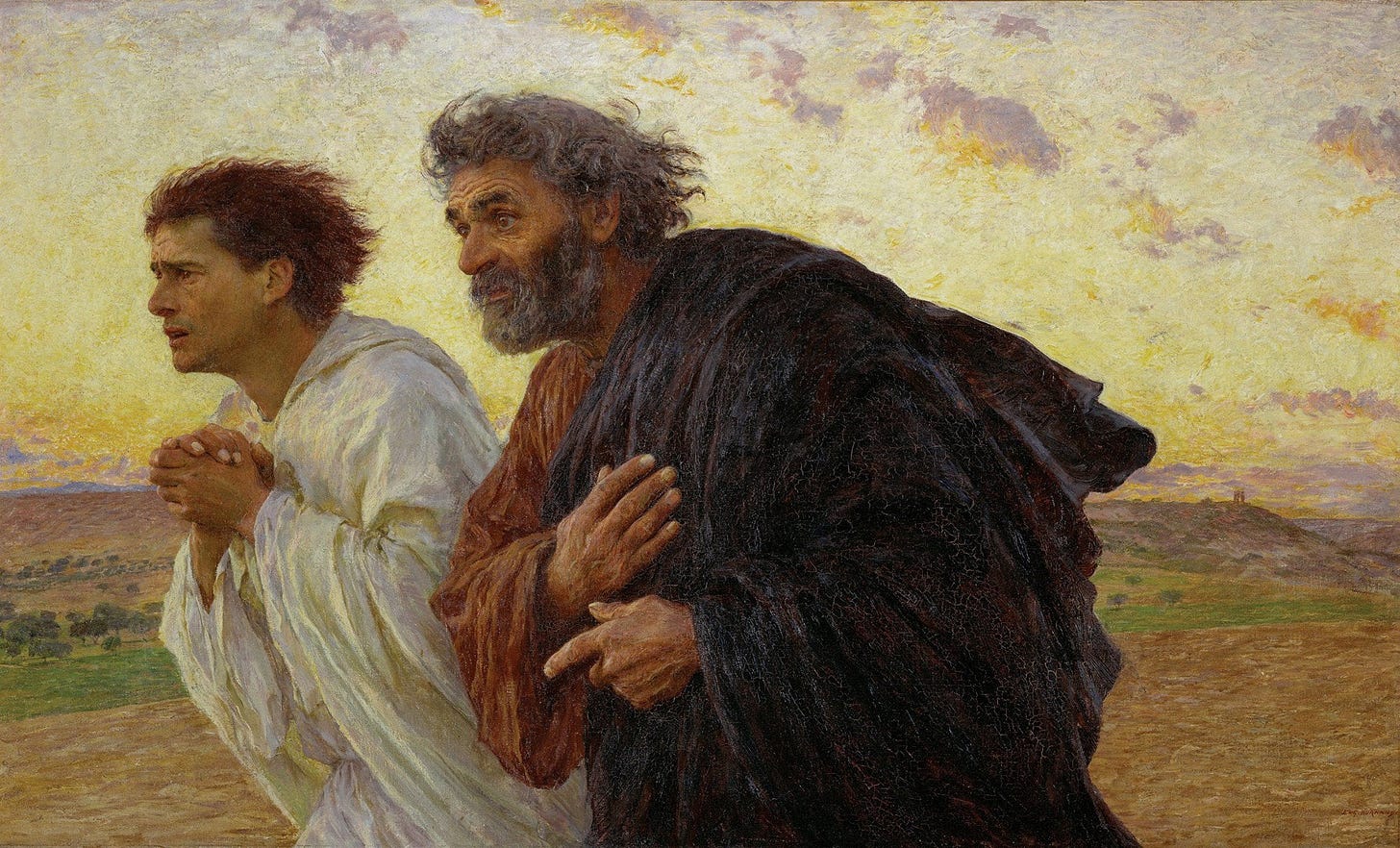Peter and John Running to the Tomb by Eugène Burnand
“both of them were running together, but the other disciple outran Peter and reached the tomb first.” John 20:4
You've probably heard a pastor make a joke about this verse. Something about how John humblebrags about outsprinting Peter to reach the tomb. It's a cheap joke but I think it speaks to a larger issue. Instead of stopping and asking why John would even mention this, rather than put in work to understand John's purpose, we take the easy way out and instead make a lame joke in our sermons(which I'm sure I'm guilty of).
In fact, John mentions this idea twice in chapter 20 (v 4, and 8). He identifies himself as the one ‘who reached the tomb first’. If we are to be serious students of scripture, we should pick up on what the author repeats. And while the answers may not come easily, we can begin asking questions:
Why does John mention this? Why twice?
Why does he identify Peter, but not himself by name?
Why does John wait to enter the tomb, while Peter goes on ahead?
What does this have to do with the resurrection?
What does this have to do with other themes in John's gospel?
In an effort to find some explanation, I reached for my commentaries on John (DA Carson, Donald Guthrie, RC Sproul, Herman Ridderbos), plus a few online options (John Calvin and Matthew Henry). It’s not scientific nor exhaustive, but I thought it would provide a decent sample of the interests of popular commentators.
While several commentators didn’t even mention John reaching the tomb first, Carson and Guthrie both explain John reaching the tomb first because of his youth. Apparently this is a historic understanding. But my question persists: Why would John mention this idea twice, if it was simply a sidenote?
Matthew Henry provides a more symbolic, spiritualized explanation. He suggests that John reached the tomb first because he loved Jesus, while Peter was weighed down by the guilt of his denial of Christ. If this is true, then why does John wait for Peter to enter? If Peter was truly weighed down by his guilt, would he have entered the tomb at all?
I grant that no commentary can contain every thought on every verse and I don’t expect them to comment on every question I raise. But for something concerning the empty grave that the author mentions multiple times, I was hoping someone would provide some insight.
I moved on from commentaries and sought out help from the Biblical Theology stream of writers. The strength of looking at themes, symbols and types in scripture is that it prevents from trying to interpret a passage in isolation from the rest of the canon. Here is a quote from Peter Leithart from his book, The Four, to set up an important theme in John’s gospel:
“The entire book can be understood as a stroll through the tabernacle. The opening chapter, which introduces the “lamb of God” who comes to take away the sins of the world, brings us to the bronze altar for sacrifice. Chapters 2-4, with their focus on water, are at the laver. Chapters 4-7 center on the feeding of the five thousand, in which Jesus distributes the bread of the presence from the golden table. In chapters 8-13, John lingers at the lampstand, musing on Jesus as the light, and the Upper Room Discourse, especially chapter 17, displays Jesus as the intercessory priest, raising his hands before the golden altar. “
This picture of the tabernacle is so rich. Notice that John isn’t making up new ideas for his gospel. He is simply pulling all of these Old Testament themes into his writings and creating even grander types and connections to Jesus. He’s a high priest, but through his signs and I AM statements, John shows just how superior Jesus’ priesthood is.
Leithart continues: “John is at pains to show us that the empty tomb is the new Holy of Holies. The slab on which Jesus body no longer lays is flanked by angels, like the ark, and Peter, like a high priest is first to enter.”
While Leithart’s observations don’t quite answer my questions, I think we’re getting closer. John’s entire gospel points to Jesus as the greater high priest of a greater tabernacle. In his prologue John says that “the Word became flesh and dwelt (tabernacled) among us (1:14)”. He tells us right away what he will highlight in his gospel. We shouldn’t be skeptical when John makes other connections between Jesus and the Tabernacle throughout the rest of his gospel.
And now at the climax of the story, we see John and Peter responding to the empty tomb like they are preparing to enter a new tabernacle. I think this gets closest to the truth, although there are still questions. I honestly couldn’t find a satisfying answer why Peter is the high priest and not John. But if Peter is a kind of high priest, John also understands this too and waits to enter the tomb.
Maybe that’s not a fully satisfactory answer. Maybe you are content to see it as John’s inspired humble brag or evidence of his earnest faith in the resurrection. But I believe there is probably more to this little episode and the priesthood and tabernacle motif gets us closer. And this is the kind of thick reading of scripture that can uncover a richness to the story that too many Christians seem to miss. Ultimately, the more questions we ask of scripture forces us to read scripture more. And reading scripture more should cause us to love the Lord and His Word more and more. And maybe someday I can find a better answer.




